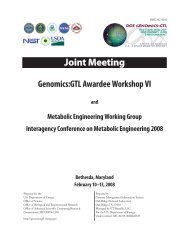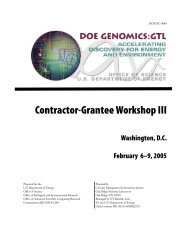Joint Meeting - Genomics - U.S. Department of Energy
Joint Meeting - Genomics - U.S. Department of Energy
Joint Meeting - Genomics - U.S. Department of Energy
You also want an ePaper? Increase the reach of your titles
YUMPU automatically turns print PDFs into web optimized ePapers that Google loves.
Milestone 1<br />
7<br />
Geobacter Project Subproject I: Genome Sequences <strong>of</strong> Geobacteraceae in<br />
Subsurface Environments Undergoing In Situ Uranium Bioremediation<br />
and on the Surface <strong>of</strong> <strong>Energy</strong>-Harvesting Electrodes<br />
Jessica Butler* (jbutler@microbio.umass.edu), Regina O’Neil, Dawn Holmes, Muktak Aklujkar, Ray<br />
DiDonato, Shelley Haveman, and Derek Lovley<br />
University <strong>of</strong> Massachusetts, Amherst, MA<br />
The overall goal <strong>of</strong> the <strong>Genomics</strong>:GTL Geobacter Project is to develop genome-based in silico models<br />
that can predict the growth and metabolism <strong>of</strong> Geobacteraceae under a variety <strong>of</strong> environmental conditions.<br />
These models are required in order to optimize practical applications <strong>of</strong> Geobacteraceae that<br />
are relevant to DOE interests. The goal <strong>of</strong> Subproject I is to determine the genetic potential <strong>of</strong> the<br />
Geobacteraceae present in subsurface environments undergoing in situ uranium bioremediation and on<br />
the surface <strong>of</strong> energy-harvesting electrodes. This not only provides information on what metabolic<br />
modules need to be included in the in silico models but makes it possible to monitor the metabolic<br />
state and rates <strong>of</strong> metabolism in diverse environments by measuring transcript levels <strong>of</strong> key diagnostic<br />
genes. In order to be as comprehensive as possible, the plan is to obtain genome sequences from:<br />
1) pure culture isolates for which there is substantial physiological information; 2) isolates from<br />
environments <strong>of</strong> interest that have the 16S rRNA gene sequences identical to those <strong>of</strong> the Geobacter<br />
species that predominate in these environments; 3) single cells from the environments <strong>of</strong> interest;<br />
and 4) genomic DNA extracted from the environments <strong>of</strong> interest. Progress has been made with all<br />
four approaches.<br />
The availability <strong>of</strong> several new Geobacteraceae genome sequences has made it possible to further<br />
evaluate the diversity within sequences <strong>of</strong> closely related members <strong>of</strong> this family. For example, an indepth<br />
comparison <strong>of</strong> the relatively well-studied genome <strong>of</strong> Geobacter sulfurreducens and the recently<br />
completed genome <strong>of</strong> Geobacter metallireducens revealed that only 60% (2131) <strong>of</strong> all genes were<br />
orthologous between the two genomes. The largest region <strong>of</strong> the G. metallireducens genome that is<br />
not present in G. sulfurreducens encoded genes for the degradation <strong>of</strong> aromatic compounds, consistent<br />
with the capacity for aromatics metabolism by G. metallireducens, but not G. sulfurreducens. Although<br />
both organisms contain genes for ca. 125 c-type cytochromes only 55% <strong>of</strong> the cytochromes in G.<br />
sulfurreducens have orthologs in the G. metallireducens genome. There are many instances <strong>of</strong> speciesspecific<br />
duplications <strong>of</strong> cytochrome genes, as well as instances <strong>of</strong> gain or loss <strong>of</strong> heme-binding motifs<br />
in orthologous cytochromes. Surprisingly, c-type cytochromes that have been shown to be important<br />
in Fe(III) reduction in G. sulfurreducens, such as the outer-membrane cytochromes OmcB, OmcF,<br />
OmcG, and OmcS, do not have orthologs in the G. metallireducens genome. Periplasmic cytochromes<br />
appear to be better conserved. For example, there are orthologs to the two periplasmic cytochromes,<br />
PpcA and MacA, previously shown to be important in Fe(III) reduction in G. sulfurreducens. There<br />
was much higher conservation <strong>of</strong> cytoplasmic proteins. For example, 87% <strong>of</strong> the 589 proteins in the<br />
current in silico model <strong>of</strong> central metabolism <strong>of</strong> G. sulfurreducens have orthologs in G. metallireducens.<br />
Of the 136 cytoplasmic genes that appear to be involved specifically in the oxidation <strong>of</strong> acetate and<br />
electron transport to the inner membrane in G. sulfurreducens, 92% have orthologs in G. metallireducens.<br />
This is significant because acetate is the key electron donor driving in situ uranium bioremediation<br />
and production <strong>of</strong> electricity. These findings suggest that modeling <strong>of</strong> the central metabolism<br />
<strong>of</strong> the environmentally relevant Geobacter species may benefit from the existing G. sulfurreducens in<br />
silico model. However, the results also suggest that there may be little conservation among Geobacter<br />
12 * Presenting author





